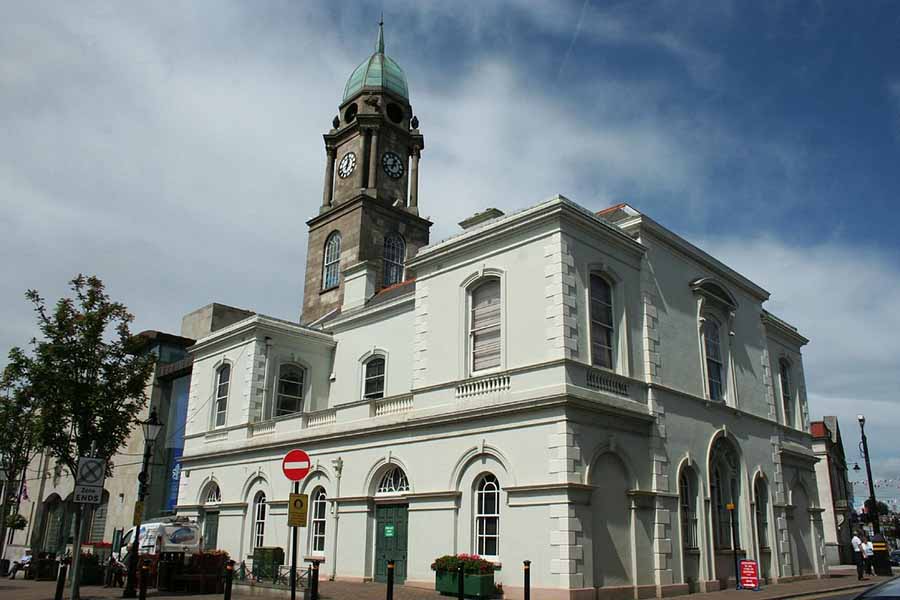
The Irish Linen Centre & Lisburn Museum, located at Market Square, Lisburn, County Antrim, (BT28 1AG), is a captivating attraction dedicated to the history of the Irish linen industry and the heritage of Lisburn and the Lagan Valley.
Housed in a 17th-century Market House, a former hub for linen trade and social events, the museum is easily accessible by car (300m from Lisburn Rail Station, limited on-street parking, disabled parking nearby), bus (Translink services, contact +44 28 9066 6630), or train (Lisburn station). It’s open Monday–Saturday, 9:30 AM–5:00 PM, with free admission, making it an accessible stop 20 minutes from Belfast.
The museum is a TripAdvisor Travelers’ Choice award recipient, praised for its educational and interactive exhibits. A visit typically takes 1–2 hours, ideal for what Tourism Ireland marketing department calls the “culturally curious”, textile enthusiasts, and families.
- Flax to Fabric Exhibition: The award-winning permanent exhibition, Flax to Fabric: The Story of Irish Linen, traces linen production from ancient Egyptian times (including a 1500 BC artefact from Tutankhamun’s tomb) to its 18th–19th century peak in Ulster, when the region was the world’s largest linen producer, employing 75,000 people. Visitors explore the process from flax harvesting to spinning and weaving, with live demonstrations on traditional spinning wheels and 19th-century handlooms, including cambric and jacquard damask looms. Expert guides like Angus or Ashleigh share engaging stories, and visitors can try spinning flax themselves, though some find it challenging (e.g., “I wasn’t much good!”). The exhibition highlights the industry’s global reach, with displays of Coulson’s damask (Royal patronage 1811, gold medal at the 1851 Great Exhibition) and designs by Sybil Connolly, worn by Jackie Kennedy, England’s Queen Elizabeth II, and Liz Taylor.
- Linen Collection Gallery: Showcases exquisite artefacts, including 17th-century damask napkins, embroidered stockings for England’s Queen Victoria, christening robes, and wares from Belfast’s Robinson & Cleaver. The Flax Flower damask design, exclusive to the museum’s shop, is available as tableware, a unique souvenir. The collection also celebrates Huguenot weaver Louis Crommelin, who revolutionized linen production in Lisburn from 1698.
- Making of a Town Exhibition: The 17th Century Lisburn display explores the city’s early development under the Conway family, Huguenot settlement, and events like William of Orange’s 1690 visit and the 1798 United Irishmen rebellion. Artefacts, maps, and stories highlight Lisburn’s role as a linen market hub, with John Wesley preaching in Market Square in 1756 and 1789.
- Temporary Exhibitions and Collections: The museum hosts rotating displays on Lisburn’s history, local artists (e.g., Blackshaw, McCloy), and themes like the Titanic or WWII. Its collections include fine art, photographic archives, and the former Linen Industry Research Association (LIRA) library, accessible by appointment (though closed during past renovations). A small fine art collection features local topographical views and Irish artists’ works.
- Guided Tours and Workshops: Free guided tours of the museum, historic Lisburn, and nearby Castle Gardens (a 17th-century fortified manor site) are available, tailored to group interests (book via +44 28 9266 3377 or ILC.Reception@lisburncastlereagh.gov.uk). Free workshops cover topics like WWII, Ancient Egypt, Science Week, and the Great War, attracting over 6,000 schoolchildren annually. The Flaxie Buds Bonanza festival for under-5s and autumn talks series add variety. Visitors praise guides like Nick for their “thought-provoking” insights, though some note inconsistent staff friendliness or tour availability.
- Facilities: The museum shop sells high-quality linen tablecloths, napkins, crafts, jewelry, and local history books, with the exclusive Flax Flower damask range. No on-site café exists (a past café closed), but nearby options include Windsor and Jeffers bakeries or Yellow Door Deli. The museum is fully accessible, with ground-floor toilets for disabled visitors and nearby public car parks. A virtual museum and free research service enhance exploration, though some visitors noted a lack of Irish-language guides, with translations in Arabic, Bulgarian, and Mandarin but not Irish (an issue the museum aims to address).
- Visitor Feedback: Praised for its “superbly presented” and “engaging” exhibits, the museum is a “hidden gem” for its hands-on spinning and weaving demos. Visitors highlight knowledgeable staff but note occasional drawbacks like limited displays, “bored” staff, or a “sanitized” view of the industry’s hardships. The free entry and central location in Lisburn’s Georgian-style Market Square, near Castle Gardens and Bow Street Mall, make it a convenient stop.
- Ongoing Accessibility Improvements: Following 2024 feedback about missing Irish-language guides, the museum is working to add Irish translations to its gallery guides, alongside existing Arabic, Bulgarian, and Mandarin options, to ensure inclusivity.
- Potential Programme Enhancements: The success of the Flaxie Buds Bonanza and schools programme suggests new family or educational events in 2025, such as craft workshops or history trails. The virtual museum may expand with new digital content, building on its award-winning platform. Monitor www.lisburnmuseum.com for updates.
- The museum’s focus on linen, a cornerstone of Ulster’s economy, is enriched by its historical setting and interactive demos, though some visitors seek broader historical context. Combine with nearby Castle Gardens, Lisburn Cathedral, or Lagan Towpath for a full day. Pre-book tours to avoid disappointment, as staff availability varies. For 2025 updates, contact ILC.Reception@lisburncastlereagh.gov.uk or call +44 28 9266 3377. Check www.lisburnmuseum.com for details.



